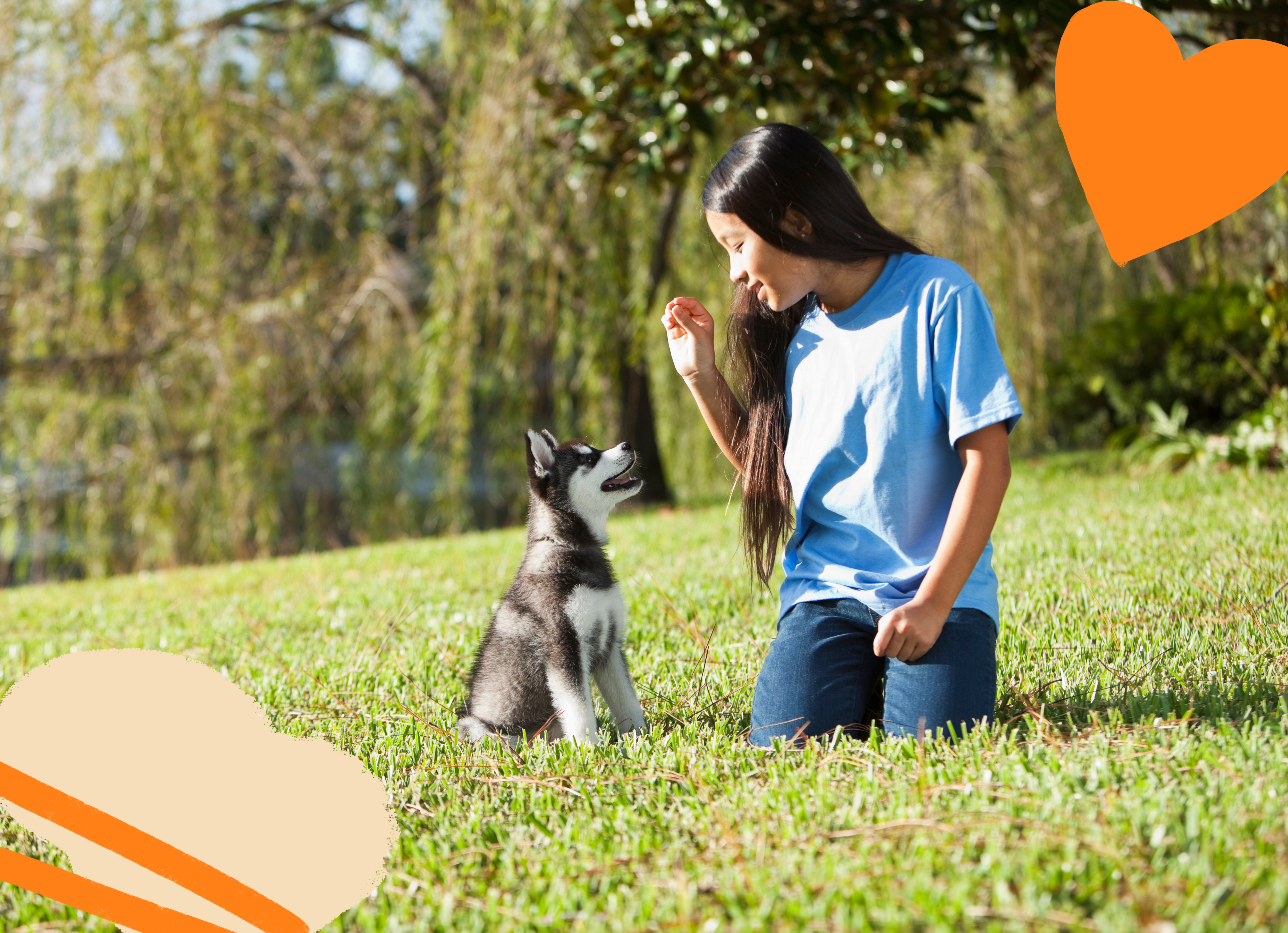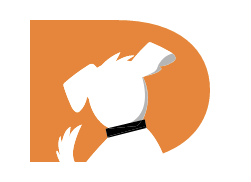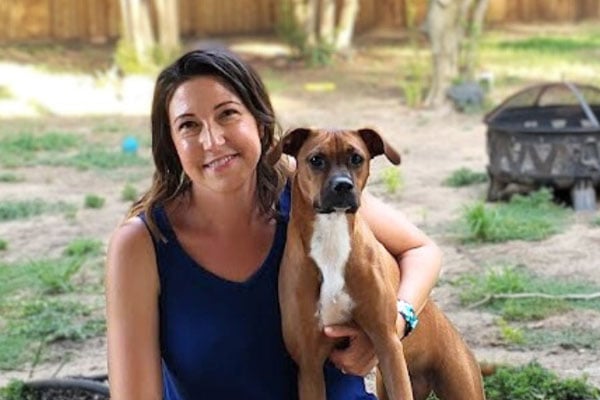
Bringing a puppy into your life is exciting but it can also be overwhelming. The DOGTV team has some helpful tips on how to socialize your puppy to get them started off on the right paw!
At DOGTV, we like to be transparent: we have affiliate relationships with other companies. We may receive a commission on qualifying purchases made via the links in this article at no extra cost to you.
Welcome to puppy parenthood!
January is National Train Your Dog Month, With that in mind, I’m here with a bit of advice to help you make the best of your new pup’s socialization.
Whether you have a brand new eight-week-old puppy or an adolescent pup, it’s never too late to implement a thoughtfully devised plan for building confidence, through positive socialization experiences.
Puppies who miss out on safely exploring new sights, sounds, surfaces, etc. may be more likely to develop fear-induced behaviors, like reactivity or resource guarding. If you’re a homebody, perhaps that’s not such a big deal. But if you’re like me, and you want a dog you can easily include in your everyday social lifestyle, certain behavior challenges can be difficult for both ends of the leash.
I love having dogs who are friendly, resilient, and unflappable – and I think it’s worth making time to support their social growth. Because let’s face it, how can we really be happy unless our dogs are too?!
Don’t worry. I’ve got a few ideas to get you started. I promise it’s possible.
First, let’s talk about the concept of socializing your puppy in the first place. Yeah, it’s got the world “social” in there. But making sure your dog is socialized is so much more than just letting them run wild and sniff as many butts as possible in the dog park! It’s conditioning your dog by carefully and slowly exposing them to a variety of interactions, all while keeping it positive.
Our goal is to limit fears before they start. Let’s teach our dogs that whatever they encounter in this wacky yet wonderful world, we will always be here to keep them safe.
Start at home
Sure, your puppy spends all his time there now – but there’s more to your home than meets the human eye. If you think about it from your dog’s POV, your house is full of new smells, sounds, textures, and experiences to explore.
Grab a bag of puppy-safe dog treats, and start with a game of hide and seek. Let your dog come find you on tile, on carpet, concrete, slippery wooden floors, up and down the stairs, and in your yard. Surprise them with a trail of treats to help create a positive association, before they have a second to think otherwise.
Next, scan your house for potentially intimidating items that you might not use as often. I know you’ve got at least a few of them. Think of a vacuum cleaner, a smoke detector, or a blow-up mattress. Sounds and sights that might be alarming if they appear out of the blue!
Ask a friend to help by turning these on while you’re with your dog at a safe distance, distracting them with a game or something yummy. Each time they hear the sound, toss them another treat, and move a little closer to the object, always keeping these training sessions short, finishing up while your dog is still having fun.
A positive association is powerful, friends. This will only reinforce how safe and comfortable they feel at home. As an added desensitization bonus, turn on DOGTV's exposure lineup while your dog is enjoying frozen enrichment.
Then take it to the streets
The best thing you can focus on the outside is nurturing engagement with your pup. It’s rude for people to excitedly hug or run up to strangers on the street. The same goes for our dogs.
Teaching our dogs to connect with us for guidance about which people and other dogs they can say hello to is one of the most important skills for a well-mannered pup.
So put a harness on your dog, put on a treat bag filled with your dog’s daily meal, and get outside! Even the few blocks surrounding your house are packed with more than enough to let your little pup do a lot of learning. Reward your dog for engagement like eye contact, along with making good choices like walking on a loose leash and stopping at every curb.
While you’re out, treat every walk like a big adventure. Use a long line for “sniffari” walks, and let your dog lead the way, stopping to smell whatever scents intrigue them.
Each spot is like a neighborhood doggie newspaper, so while it’s not direct, your pup is still getting exposed to other pups! Allow your dog to climb fallen trees, steps, hills, curbs… let those puppy paws parkour all over your neighborhood, the mental enrichment will never get old!
Live next to a quiet trail? Go explore it! Live near the beach? Check it out! Got a playground? Go while kids are in home school. Got train tracks nearby? Walk along when you know there are no trains scheduled. Live near a dog park? Take a walk outside the fence, at a far distance. There’s literally no limit to the new places you can safely explore, while you train your dog.
Socialize – within your bubble
Do you have anyone in your circle? A partner, roommate, or human family? Great! I’m sure it won’t take much convincing to ask for their help training your new puppy. And not to worry if you do live alone.
Maybe there’s a close friend or family member nearby who can mask up for a meetup! Allowing your pup to meet, play, and practice their training cues with other friendly folks helps reinforce good social interactions.
We all have different smells, voices, and body movements; the more our dogs experience safe, enjoyable “strangers” the more comfortable they’ll be around new people as they grow up.
The same goes for meeting other NICE, trustworthy dogs. This is where a certified professional dog trainer can be especially useful if they have a stable adult “demo dog” like my Delilah Jane.
Puppies can learn bite inhibition and healthy play habits by spending time with other vaccinated, similar-sized puppies, as well as good-natured adult dogs who can communicate fairly with body language and gentle guidance. If you don’t know anyone with a reliable adult dog or puppy, I always recommend asking your veterinarian or posting on NextDoor to set up playdates.
Introduce the dogs on neutral territory, like a walk together or an enclosed area that isn’t either of your yards and let them get their puppy party on.
Engage all those senses – even taste
We’ve talked about seeing stuff. Smelling stuff. Feeling stuff. Hearing stuff. But have we talked taste? Yummy, both my dogs’ and my favorite of the five senses!
Now’s the time to show your puppy what the wonderful world of food is, to help learn about what they consider high-value reinforces. Over the course of a few weeks, let them try all kinds of different yummies. Foods that crunch. Foods to chew. Soft baked treats. Plenty of whole foods, like chicken, steak, fish, sweet potatoes, broccoli, and apples. You might be surprised what a veggie-lover your little pup turns out to be!
By the end of their puppyhood, there will be no picky eaters in sight. And by offering taste tests you can better decide how to motivate your dog when training!
Go on a field trip
First of all, get your puppy used to riding in the car. Find a crash-test crate or harness to keep them safe. Because chances are, post-pandemic, we’re all going to be ready for lots of human socialization, and the more dog-friendly, the better. Now is the time to lay that travel foundation of road trip = good times.
Focus on training
Positive reinforcement training is the best way to build a bond with your dog and keep their minds working. And as you keep on rewarding them for any movement in the right direction, you’re cementing good behavior patterns that will outlast these socially distant times. To get started, here’s a list of DIY training videos I created.
One day, this global pandemic will end (hopefully), and everything will go back to normal (please). And when that day comes, I hope you’ll emerge back into the real world with a dog brave enough to face anything, with you at their side. I swear, it will all be worth it.
Please, if you have any doubts, questions or specific challenges ~ always consult with a local, certified professional dog trainer who can help give you specific advice for your dog’s needs and lifestyle situation.
Love, doggedly… Laura Nativo, CPDT-KA, KPA CTP

 Lindsay Millican
Lindsay Millican